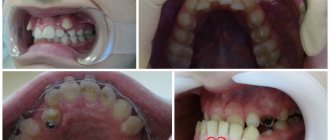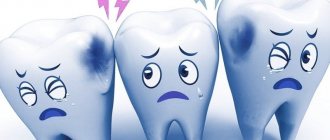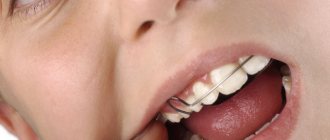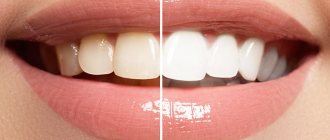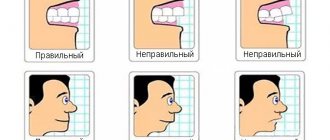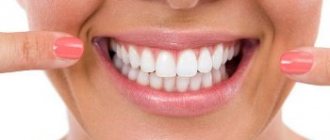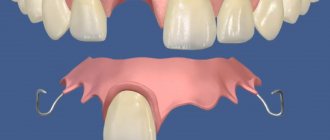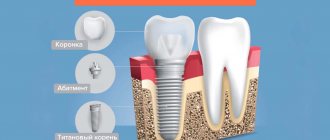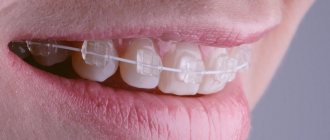- Crooked teeth
- The appearance of a second row of teeth in the jaw
- When permanent teeth do not appear for a long time
- How to distinguish baby teeth from permanent ones?
The complex process of replacing baby teeth with permanent ones is often painful and accompanied by a number of problems. The most common of them is malocclusion. The second most common problem is the appearance of a second set of teeth. Also, many parents are faced with the fact that their child’s molars and incisors do not appear for a very long time.
What is retention
Retention is a delay in the growth of baby or molar teeth. With this pathology, the tooth may erupt, but not completely, but can be barely visible above the gum, and it can also grow only under the gum, not showing out at all. First of all, this disease affects the second premolars and third molars located on the lower jaw, as well as the canines of the upper jaw. Maxillary canine impaction is much more common in women. This pathology can occur on one side of the jaw or on both sides at once. Canine impaction in the lower jaw is a very rare occurrence. Impaction of primary teeth is also extremely rare. Such disorders in children can be caused by an acute lack of vitamins in the body or serious pathologies during teething. Impaction of primary teeth can be caused by severe rickets.
How dentists fight dystopia of “eye” teeth
Determining the curvature of the fangs is quite simple - to do this, the dentist just needs to examine the condition of the client’s oral cavity. When choosing a treatment method, the following criteria are taken into account:
- patient's age;
- features of the existing anomaly;
- degree of neglect of dental pathology.
To remove the curvature and force the canine into the correct position, the doctor may resort to the following treatment options:
- installation of braces on fangs;
- use of mouth guards;
- removal of “eights” (necessary if they are the cause of a dental anomaly);
- transformation of the first molar into a canine if the latter is missing;
- reposition (used exclusively in the most severe cases).
The sooner treatment of the curvature is started, the higher the likelihood of its complete elimination in a short time. If we are talking about providing orthodontic care to children under twelve years of age, then they are advised to wear removable plates. Typically, this method can achieve a beautiful smile in early adolescence in just six months.
Teenagers fourteen years of age and older can return the canine to its natural place with the help of braces. Adults often have to not only wear braces, but also undergo a simple surgical operation.
Types of pathology
Teeth eruption disorders can be of two types: complete and partial, and the tooth, respectively, impacted and semi-impacted. The last type means that the tooth has erupted a little, i.e. visually observed above the gum. The impacted tooth is completely hidden by the gum and is not accessible to palpation. According to the depth of their occurrence, such teeth can be tissue embedded (the tooth is located in the gum tissue) or bone embedded (lies in the jaw bone). Such teeth can be located:
- Angularly, i.e. at an angle.
- Vertical.
- Horizontally.
Sometimes there are so-called reverse impacted teeth, most often these are the lower eighth teeth. In such teeth, the upper part is turned towards the jaw, and the roots are turned towards the alveolar edge. There are also symmetrical, unilateral or bilateral tooth retention.
Let's smile together!
I want to tell you about such an important factor in treatment as emotions. If the attending physician, as a rule, always directs emotions in a positive direction, since correcting the patient’s bite is his profession, then for the patient, every moment of improvement in his current condition, or vice versa, every small anxious moment is a surge of emotions. That's right, because the patient begins a new life with a beautiful smile, and for him in this new life there is already a place for openness and positive impressions.
During treatment with aligners, as agreed, the patient very actively communicated with me using messengers.
Why does a canine or molar not appear?
The concept of retention refers to the anatomical specificity of the jaw or an anomaly in the formation of the tooth germ. Experts believe that this pathology arose in modern society as a result of eating too soft food, i.e. people have practically stopped chewing solid food. Other reasons why retention may occur:
- improper feeding of the child;
- reduced immunity associated with exposure to infections;
- delay in replacing milk teeth with molars;
- the presence of supernumerary teeth that prevent the eruption of a permanent tooth;
- incorrect location of the permanent tooth germ in the jaw bone. With this pathology, the crown of the tooth is directed towards the root of the adjacent tooth, thereby preventing its appearance and the eruption of neighboring teeth;
- bad heredity.
Preparing for treatment
A panoramic photograph of the teeth was taken, an X-ray of the skull in a lateral projection (TRG-lateral), and impressions of the teeth were taken. The teenager underwent consultation with an osteopath, speech therapist, and pediatric dentist. Photometry was taken - the face and teeth from different angles.
Initial situation:
At a consultation with an osteopath , the osteopath did not identify any significant problems regarding the musculoskeletal system that could affect the bite. A small correction is proposed after each visit to the orthodontist in order to compensate for the influence of orthodontic equipment - to relieve tension in the bones of the skull, temporal joints, and neck.
At a consultation with a speech therapist , the condition of the muscles of the lips and tongue was tested. A decrease in tongue muscle tone and improper swallowing were revealed. A list of exercises is given that you can perform independently to train the muscles of the tongue and neck.
A consultation with a pediatric dentist revealed caries on one of the teeth, which must be cured before orthodontic treatment .
Consultations with specialists are provided free of charge. A feature of the treatment at Olga Baranova’s ORTHODONT PROJECT is an integrated approach to treatment - the interaction of different specialists aimed at eliminating all negative factors that disrupt the position of the teeth, which gives more stable results of orthodontic treatment .
The results of all consultations and examinations were sent to the orthodontist . The doctor carried out the necessary calculations, and on the second visit she explained the treatment plan, and also offered several braces to choose from.
The Damon self-ligating bracket system was chosen. In this bracket system, the braces are small in size with rounded edges. braces on the upper front teeth , which are less noticeable to others. It is better to use Damon Q metal braces to protect the upper teeth from excessive wear. When smiling and talking, the lower teeth are covered by the lip, and the aesthetics are not greatly affected.
After the brace system was approved, a treatment contract was signed and the cost of the brace system was paid. Payment for treatment can be made in full or in stages - half when fixing braces
and the balance in equal parts at each visit.
To maintain the health of the teeth while wearing braces, before fixing the braces as a gift, hygienic preparation of the teeth , including removing plaque using the Air Flow method, removing tartar with ultrasound, and polishing the surface of all teeth. The hygienist explained on a model the rules for brushing teeth with braces with a special orthodontic brush, showed how to use dental brushes, a single-tuft brush and special dental floss to clean braces and interdental spaces.
The next step will be fixing the braces , which is the beginning of orthodontic treatment.
The main symptoms of the pathology
Retention in dentistry is quite common, and there are some signs by which this pathology can be detected:
- pain in the gums, radiating to the ear and temporal part;
- regular injury to the same place in the oral mucosa;
- numbness and swelling;
- painful sensations when opening the mouth and while chewing food;
- mobility or displacement of teeth;
- deterioration of general health due to the inflammatory process (fever, weakness, chills, etc.);
- the appearance of a cyst or abscess.
Consequences of malocclusion
If the defect does not create physical inconvenience, then you can ignore it. This is a misconception held by many people who experience protruding front teeth. In fact, this is not only an aesthetic flaw.
Incorrect bite leads to very disastrous consequences, various kinds of complications affecting all organs and systems.
Here are some of them:
- 1. Accelerated tooth decay. Uneven chewing load leads to grinding of incisors, formation and development of caries.
- 2. Deformation of the facial part of the skull. An aesthetic defect that affects the beauty of a smile, the appearance of the profile.
- 3. Disruption of the gastrointestinal tract. With an incorrect bite, chewing food is not of sufficient quality, which leads to diseases of the digestive system.
- 4. Development of periodontal disease. Inflamed gums cause physical discomfort. In addition, they can cause tooth loss.
- 5. Impaired functioning of the temporomandibular joint. If the problem is ignored for a long time, neuralgia and arthritis develop.
Protruding front teeth are the tip of the iceberg, underneath which lies a huge number of problems. The consequences of malocclusion worsen over the years. They concern not only the oral cavity, but the whole body. With protruding front teeth, beautiful diction and correct articulation are impossible. In addition, they can make breathing difficult. If the bite is incorrect, prosthetics become more difficult.
Elimination of anomaly
Treatment of retention is a rather complex process that requires qualified assistance from dentists of several specializations. Treatment is selected individually for each patient and depends on the clinical picture of the oral cavity. The first question that a dentist needs to decide is whether to remove or save a diseased tooth. There are several treatment methods, most often this is a surgical intervention in which a specialist cuts the gingival hood so that nothing prevents the tooth from erupting outward. Surgical procedures of this kind are used in situations where the tooth grows correctly and does not interfere with neighboring teeth. In other cases, most often, the tooth is removed. Removing an impacted tooth is a rather difficult operation. The procedure is carried out under local anesthesia, after which the gum is cut, and the specialist uses a bur to create access to the tooth, after which it is completely removed. Then a special medicine is placed into the tooth socket. If necessary, sutures are applied and removed ten days after the procedure. Swelling may occur after removal of an impacted tooth. Most often, after removing such a tooth, the doctor prescribes antibiotics and painkillers. Also, the patient, for the first few days, needs to stop eating solid foods, hot and cold foods and drinks.
Causes of protruding teeth
Most often, the two central teeth protrude forward due to the large grouping and strong pressure of the dentition. Also, the reason may be their initially incorrect position. But it is possible that there is a malocclusion after correction. Many people who wear braces experience a similar problem: protruding front teeth.
There are several causes of the pathology:
- 1. Premature cessation of treatment. External improvements do not always mean full recovery. When braces are removed prematurely, the central teeth gradually move forward.
- 2. Failure to comply with doctor's recommendations. Unauthorized cessation of alignment naturally leads to the return of bone tissue to its original place.
- 3. Incorrect installation of braces. It is possible that the arc tension is insufficient or certain anatomical features of the patient are ignored.
- 4. Rare visits to the supervising orthodontist. Throughout the entire correction period, it is important to make changes and also monitor the design of the braces, which can break without a person noticing.
5. The most common reason for protruding front teeth is ignoring the retention period. After the braces are removed, the treatment does not end, but continues. Every competent doctor knows how important it is to consolidate the result. A frivolous attitude and refusal to further consult an orthodontist will inevitably lead to the return of previous defects.
Conclusions. Expert advice
Crooked teeth can appear for various reasons, ranging from heredity to bad habits. Both primary and permanent elements of the dentition grow incorrectly, and the “eights” of wisdom are almost always not formed correctly enough. Tooth curvature is not only a childhood disease. Trauma, age-related changes, or even a love of chewing pencils can cause problem teeth in adults.
It doesn’t matter whether you have one or several crooked incisors, you definitely need treatment. The first thing you need to do is contact a therapist, and then an orthodontist, who will decide what to do with crooked teeth in your situation. There are quite a few treatment methods, each with its own pros and cons. Sometimes the doctor decides to combine several methods, for example, installing braces and prescribing wearing a trainer. In especially severe cases, surgery is used.
Lack of treatment is very dangerous, because when teeth are crooked, the load during chewing is distributed unevenly. The longer the patient waits, the more severely some elements of the dentition wear out, leaving others without work. This leads to premature loss of molars and incisors. This is followed by bone depletion and expensive implant surgery, if it is possible at all. Avoiding such a development of events is not so difficult: you need to visit the orthodontist in time and correct the bite.
Interesting moments that the patient described about the sensations on the aligners
The patient noted in the messenger that his tooth (fang) was moving and he was afraid to remove the aligner along with the fang! The movement of the canine as a result of removing crowding does occur, and as a result, tooth mobility can actually be felt. But since all dental movements during treatment with aligners are planned in advance, and the patient’s teeth are reliably protected in the aligners, all worries were removed.
As I told you earlier, once on a business trip in a restaurant, when he forgot the container and put the aligners next to him on a napkin, the children at the next table laughed that he had taken off his dentures
In fact, aligners can and should be stored in a special container while brushing your teeth or eating
Problems of treating crowded teeth with aligners
There were no problems at all with wearing the aligners. The only thing is that the activator came off once - this was after six months, but this was quickly eliminated and did not affect the course of treatment.
There was a case when a patient went on vacation and did not take his mouthguard retainer with him - his internal retainer came unstuck and the tooth moved back a little, “rotated” as orthodontists say. Now the problem is over.
